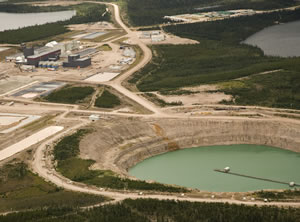Uranium mines and mills
Uranium mines and mills are regulated and licensed by the Canadian Nuclear Safety Commission (CNSC).
Introduction to uranium
Uranium is a naturally occurring radioactive element used for fuel in nuclear power reactors. Canada is one of the world’s largest uranium producers and most of Canada’s production is exported.
Uranium is mined to provide uranium ore, which is processed at a milling facility to produce uranium concentrate. The uranium concentrate is then processed to create fuel for nuclear reactors.
Regulating uranium mines and mills

The CNSC regulates and licenses all current and future uranium mining and milling operations in Canada.
The CNSC ensures uranium mines and mills follow the comprehensive requirements of the Nuclear Safety and Control Act (NSCA) and its related regulations. These regulations reflect Canadian and international safety standards and help to keep people and the environment safe.
The CNSC also ensures Canada carries out its international obligations on the safe use of nuclear materials by making sure these requirements are met.
Licensing process

The CNSC’s licensing process for uranium mines and mills follows the stages described in the Uranium Mines and Mills Regulations. The licensing process moves through these phases:
- site preparation and construction
- operating
- decommissioning
- abandonment (or release from licensing)
The CNSC uses a lifecycle approach to licensing, issuing licences for all phases in the lifecycle of a uranium mine and mill.
The CNSC monitors all licensees for regulatory compliance to ensure the safety of workers, the public and the environment. We also ensure that each licensee has a financial guarantee in place to cover the eventual decommissioning costs of a facility.
The CNSC determines at each licensing stage whether the licence applicant is qualified. The Commission determines if the licence applicant has made adequate provisions for the protection of health and safety of people and environment.
Applicants must also demonstrate the required measures to maintain national security and apply Canada's international obligations for the peaceful use of nuclear energy. In addition, uranium mines and mills are also subject to applicable environmental review requirements. For further information, please visit the CNSC’s Environmental reviews page.
CNSC compliance activities
CNSC staff perform compliance activities for operating and decommissioned mines and mills. Compliance activities include:
- facility inspections
- application requests
- review of licensee reports
- environmental, radiation and conventional health and safety data analysis
Inspectors certified by the CNSC conduct regular inspections at operating and decommissioned facilities. These inspections are shared with employees at the facility, the Northern Saskatchewan Environmental Quality Committee and other regulators.

Inspections are conducted with other regulatory agencies, such as:
- the provincial or territorial departments of Environment and Labour
- representatives from other federal government departments (for example, Environment Canada and Fisheries and Oceans)
An example of an area the CNSC regulates is radon exposure in uranium mines and mills. The CNSC requires licensees have engineering design and control processes to remove radon to limit exposure to workers. Radon is naturally produced by the decay of uranium and is released into the air when uranium ore is mined and milled.
Radon gas produced during mining and milling is continuously monitored, controlled, and safely ventilated away from the workers. Worker exposures to radon in the uranium mining and processing industry are as low as, or only slightly greater than, public exposure from natural radon.
Licensees must notify the CNSC about significant events or situations outside the normal operations that are:
- described in their licensing documents
- due to public interest
Such events rarely, if ever, result in significant effects on the health and safety of people or the environment.
Significant events are reported to the Commission through event initial reports. These reports may be followed up, depending on the nature and severity of the event, with:
- detailed compliance activities focused on the licensee
- corrective actions and/or
- regulatory action taken by the CNSC
Read the CNSC staff report on the performance of uranium and nuclear substance processing facilities for the most recent analysis of:
- worker health and safety
- radiation protection
- environmental performance
Operating uranium mines and mills

All operating uranium mines and mills in Canada are located in northern Saskatchewan. Orano Canada and Cameco Corporation are the licensees of these active mining and milling facilities:
- Cigar Lake Mine
- Key Lake Mill
- McArthur River Mine
- McClean Lake Mine and Mill
- Rabbit Lake Mine and Mill
Surface exploration for uranium is exempt from NSCA requirements because it poses low risks. Each province or territory is responsible for:
- regulating and monitoring exploration activities within its jurisdiction
- informing the public about those activities
Advanced exploration activities, such as exploration ramps through mineralized zones, may fall within the regulatory framework of the CNSC. A licence may be required before these activities can begin.
Operating licences for uranium mines and mills, as with other major facilities, are issued for specific time periods. These are usually from 10 to 20 years. Renewals of existing licences and all proposals for new mining and milling activities must receive Commission approval.
Proposed uranium mines and mills
New uranium mine and mill projects are currently being proposed in Saskatchewan.
Proposed uranium mines and mills are subject to applicable environmental review requirements. For further information, please visit the CNSC’s environmental reviews page.
The CNSC’s licensing process for new uranium mines and mills follows the stages outlined in the Uranium Mines and Mills Regulations. The process moves through these phases:
- site preparation and construction
- operating
- decommissioning
- abandonment (or release from licensing)
Environmental assessments can also be completed for new projects at existing nuclear facilities.
| Project | Location | Licensee / applicant |
|---|---|---|
| Wheeler River | Northern Saskatchewan | Denison Mines Corporation |
| Rook I | Northern Saskatchewan | NexGen Energy Ltd. |
| Patterson Lake | Northern Saskatchewan | Paladin Canada Inc. |
Related links
Page details
- Date modified: